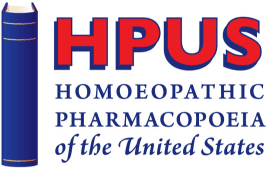The Hahnemann Monument, the Story of Its History and Its Architecture
by Sandra M. Chase, MD, DHt 10/30/2022
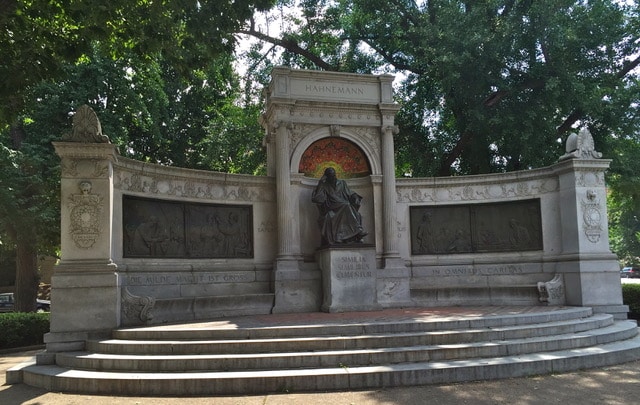
all photos courtesy of Dr. Chase
In 1881, Dr. J.H. McClelland, Pittsburgh, PA, made the first proposal for the American Institute of Homeopathy (AIH) to erect a monument to Hahnemann in Washington, DC. His proposal was prompted by two events.
The first was his visit to the birthplace & gravesite of Galileo of whose history of suffering persecution for his discoveries and for Truth’s sake Dr. McClelland was aware.
The second was his awareness of the largest gathering of medical men of 19th C in England to honor William Harvey, the discoverer of the circulation of blood, with a statue. Like Galileo, he was persecuted for his discovery.
In 1892, Dr. J.H. McClelland put forth his 2nd proposal at the American Institute of Homeopathy’s annual session, held in Washington, DC, with his motion to construct and to place such a monument in our nation’s capital. His motion was seconded by Dr. Henry N. Smith of New York. The enthusiasm for the proposal was such that over one thousand dollars, $1,000.00, was subscribed at that meeting. The estimate was offered that the total funds needed would be $50,000 to $75.000 dollars.
The American Institute of Homeopathy faced three challenges to achieve their worthy goal. One, they had to amass the funds; two, they had to engage a sculptor; and three, they had to shepherd the legislation through Congress and have the President sign the legislation.
A Monument Committee was appointed in 1892 (which functioned until 1902) and initiated fundraising. The plan to erect a monument to Hahnemann was publicized in homeopathic journals but Old School MD’s blocked general press coverage. Nevertheless, the project quickly grew from representing 1400 members of the AIH to 12,000 homeopathic physicians in the USA.
In 1893 the Committee reported that progress was being made and an Auxiliary Committee was appointed made up of a representative from each state and each college. The AIH pledged another $2500, afterward increased by another $500.00 pledged.
At the 1894 47th Annual Session of AIH held in Denver $15,000 was pledged. The Committee was advised to pick a European sculptor; while there was some disposition to pick an American, they determined to pick the best. Being medical doctors but not artists the Committee consulted the well-recognized head of American sculpture, Mr. J.Q.A. Ward, President of the National Sculptors’ Society.
The Hahnemann Monument Committee had enlisted the aid of the National Sculptors’ Society to judge the competition for the Hahnemann Monument. National Sculptors’ Society President Ward had recommended that the committee send letters to 60 sculptors, American and foreign, inviting them to submit sketches as models for a monument with a “heroic statue …with a granite pedestal, having such elaboration and accessories as would commemorate Hahnemann’s life and work…”
The cost…” (≤$30,000), the likeness, the time of delivery (02/01/1895), erection of the monument, manner of payment, etc., were specified. Prizes of 1st) $500, 2nd) $300, and 3rd) $200 were offered for the best submissions.
Thirty sculptors accepted, and 24 models were received, representing American, French, German, Italian, and Spanish sculptors. Their submissions were placed on public display at the American Gallery of Fine Arts, the finest in NYC.
The Committee of the Sculpture Society and the Monument Committee unanimously chose Charles H. Niehaus (Cincinnati, OH), a prize-winning sculptor, as the winning sculptor. Their chosen architect was Julius H. Harder of New York, NY, of the firm March, Israels, and Harder. The Monument Committee also decided to have the monument erected in granite ($48,800) rather than Indiana limestone ($30,000). The contract between the AIH and Mr. Niehaus is contained in the transactions of the AIH.
Charles Henry Niehaus was born on January 24th, 1855, in Cincinnati, OH, of John Conrad Niehaus and Sophia Block Niehaus, both German immigrants. As a youth, he practiced wood carving, stone cutting, and marble carving. He attended the McMicken School of Design in Cincinnati. Some high points of his life follow:
- 1877 Royal Academy, Munich, graduated 22y, 1st American to win a medal
- went on to study in Rome
- 1880 married Letitia Gorman. One daughter, Marie
- 1881 returned to OH, commissioned to sculpt recently assassinated President James Garfield
- 1897 Moses & Edward Gibbon sculptures installed in the Library of Congress.
- No less than 8 pieces of his sculpture are displayed in the US Capitol
- 1896 Completion of the full-sized model in clay of Hahnemann
- 1898 Completion of the granite exedra and pedestal by Maine and New Hampshire Granite Company and of the bronze statue and entablatures by the Gorham Manufacturing Co.
- 1900 Married Regina Armstrong, an art critic
- He worked until the final year of his life when health forced him from his NJ backyard studio.
A Commission of the Site proposed Scott Circle for the placement of the monument, it being in a direct line from the White House. Approved.
Newport, RI, was the site at which the 51st Session of the AIH convened in 1895. The occasion became practically a reception for the winning sculptor, C. H. Niehaus, and its architect, Julius Harder. A model of their winning entry and other submitted sketches were on display.
In 1896, a full-sized model was completed. Since statuary erected in Washington, DC, required Congressional approval, a bill was introduced and passed Congress. President Cleveland did not sign the legislation.
In 1897 the Meissen Society and Ladies Monument Association were created to support the fundraising effort. Dr. Nancy T. Williams (ME) was the largest single individual contributor, with $4,510.
At the 1898 54th Session of the AIH held in Omaha, NE, the memorial was in a state of practical completion. The granite work had been accomplished by Maine & New Hampshire Granite Company. The Bronze entablatures had been achieved by Gorham Manufacturing Company. Importantly, a new bill was introduced in Congress to authorize the site.
In 1899 the 55th Session of the AIH convened in Atlantic City, NJ. A Finance Committee was appointed to amass the funds. The good news was that a bill had finally passed Congress in the fall of 1899. Then President William McKinley signed the bill. To achieve that end, two Congressional objections that this was starting a sectarian precedent and that Hahnemann was not of our country, had to be allayed.
A meeting was held in Washington, DC, in 1900 to determine the location and date of the AIH Annual Session that year. The guarantee of the Monument Committee resulted in the selection of Washington, DC, as the site for the AIH Session and June 21, 1900, as the date of the dedication of the monument.
The invited guests to the unveiling and dedication of the Hahnemann Monument included the following luminaries:
- the Guest of Honor President William McKinley,
- his Private Secretary George B. Cortelyou,
- the President of the District Board of Commissioners Hon. Henry B.F. MacFarland,
- the Chief of Engineers General John M. Wilson, USA,
- the Superintendent of Public Buildings and Grounds Col. Theodore A. Bingham, and
- Attorney General John W. Griggs.
The official representatives of the American Institute of Homeopathy (AIH) were as follows:
- President of the American Institute of Homeopathy Dr. Charles E. Walton,
- Secretary of the AIH Dr. Eugene H. Porter,
- Poet of the Day Dr. William Tod Helmuth,
- Chairman of the Monument Committee Dr. James H. McClelland,
- Treasurer of the Monument Committee Dr. Henry M. Smith,
- Chairman of the Finance Committee Dr. George G. Shelton
- Chairman of the Local Committee on the Monument Dedication. Dr. J. B. Gregg Custis
- Largest individual contributor Dr. Nancy T. Williams
- Rev Benjamin F. Bittinger, DD
- President’s Own Marine Corps Band
The AIH-hosted Rededication Ceremony was held on June 21, 2000, at the site of the monument. There was some attempt to plan an event like the original dedication on June 21, 1900. While we did not have President Clinton there, we did have the Brass Quintet of the Marine Corps Band and a Uniform Services Color Guard.
The Participating Organizations included:
- The Academy of Veterinary Homeopathy,
- The American Association of Homeopathic Pharmacists,
- The American Health Products Association,
- The Homeopathic Academy of Naturopathic Physicians,
- The Homeopathic Nurses Association,
- The Homeopathic Pharmacopoeia Convention of the United States
- The Homeopathic Research Network
- The National Center for Homeopathy,
- The North American Society of Homeopaths,
- The Council for Homeopathic Certification
- The Centre for Homeopathic Education.
Supporting state and regional homeopathic societies were in attendance, as follows: CA, NY, PA, IL, OH, and the Southern Homeopathic Medical Association.
Officers, Trustees, and members of the American Institute of Homeopathy were in attendance as were Homeopathic dignitaries from around the world. Participants in the AIH-hosted Homeopathy 2000 Celebration and Rededication Conference were in the audience.
That event made it apparent that our Hahnemann Monument needed significant restoration. While the Hahnemann Monument is within the purview of the federal government, most particularly the National Park Service (NPS), Central Division, consultation with those officials made it clear that other important historic monuments in Washington, DC, held precedence.
Therefore, to facilitate the necessary renovations a private fund drive would have to be undertaken to achieve our restoration goals. A promise was made that, once the restoration had been completed, the NPS would host a public ceremony on the site honoring that achievement.
Restoration fundraising under the auspices of the AIH Hahnemann Monument Restoration Project (HMRP) started in the summer of 2000, and by October 2003 it had amassed over $30,000, much to the surprise of the NPS Central Division Superintendent.
On October 29, 2003, there was a meeting in my professional office with Glenn DeMarr of NPS. November 13, 2003, we met on-site with NPS Officials.
On April 5, 2004, we transferred $20,600 of the HMRP funds to NPS’s Karen Cucurrulo to pay for Senior Conservator Judith Jacob (NY) to restore gold-leaf backed colored Italian glass tesserae that depicted a stylized image of Cinchona officinalis within the arch located behind and above the head of the statue.
The glass was ordered from Italy via an American supplier. Additional restoration included work on the statue itself, along with the cleaning of the bronze entablatures depicting four stages in Hahnemann’s life.
The monument’s granite was cleaned and repointed in a manner not to destroy its integrity. Also, the steps and the plaza had portions raised and re-laid.
The Hahnemann Monument: The History Within
The Hahnemann Monument is designed in a Greek exedra form in which there is a large niche or recess, usually with a bench or seat, semicircular or rectangular, roofed or unroofed. The elliptical shape is approached by four steps at the minor axis to the platform at the rear of which rises a superstructure. (*A donor list is secreted somewhere in the monument.)
The central portion is composed of four columns with the statue of Hahnemann seated in front. Above the head of the statue arises an attica bearing his name. (*The sculptor’s signature is at the base of the statue.)
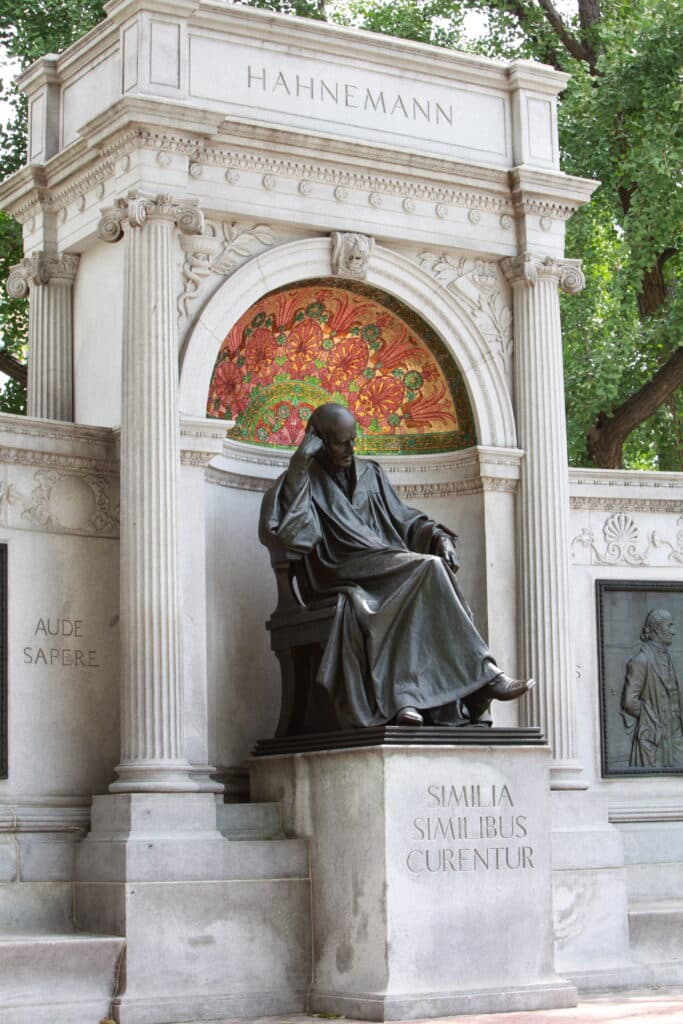
Behind the bronze statue of Hahnemann, between the two front columns is an elliptical niche in the vertical axis, terminating in a semicircular arch above the impost. The impost line stretches out to the right and to the left, forming the vertical termination of the flanking walls, which end at the extremities of the major axis of the ellipse. The base courses of these curving granite walls form seats occupying the space between the central portion and the end terminations.
Because at the time that the monument was erected, it stood in an open space, it was determined to make it attractive from all aspects. The main lines of the central portion repeat on the back, the niche being replaced with a flat curtain wall with a decorated tympanum above the impost. Above that appears the following: MCM: 1900.
The two figures represent the art and the science of medicine.
The Tablet reads the following: Christian Friedrich Samuel Hahnemann, Doctor of Medicine, Hofrath, Leader of the Great Medical Reformation of the Nineteenth Century, Founder of the Homœopathic School. (*Hofrath: Counselor to the Court, honorary title.)
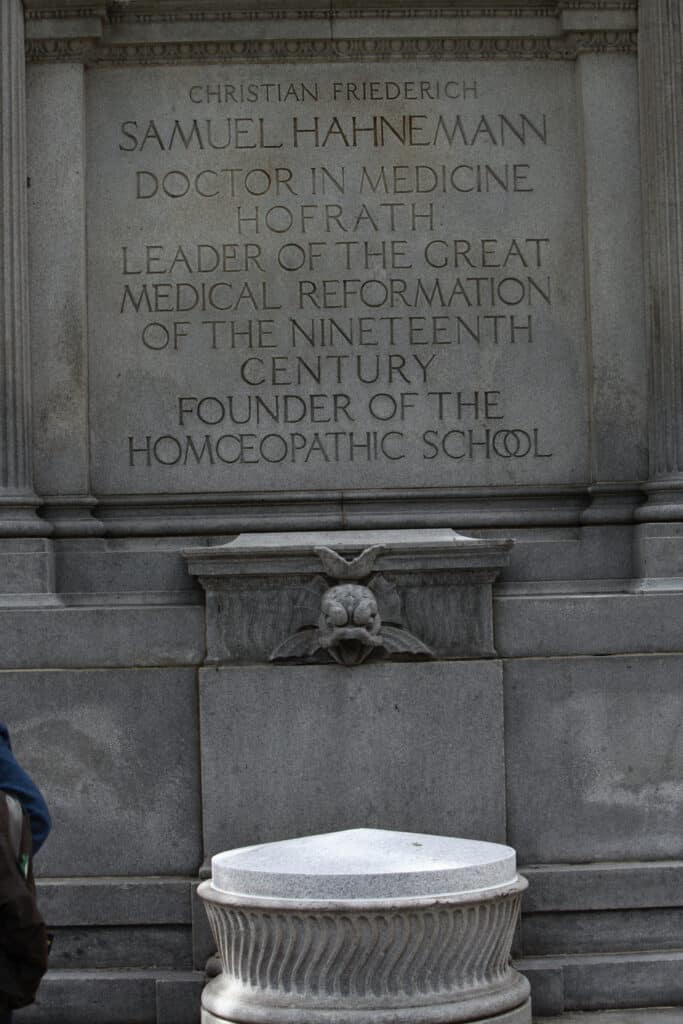
The inscription of Hahnemann’s birth date and place appears on the rear of the right wall, encircled with laurel leaves.
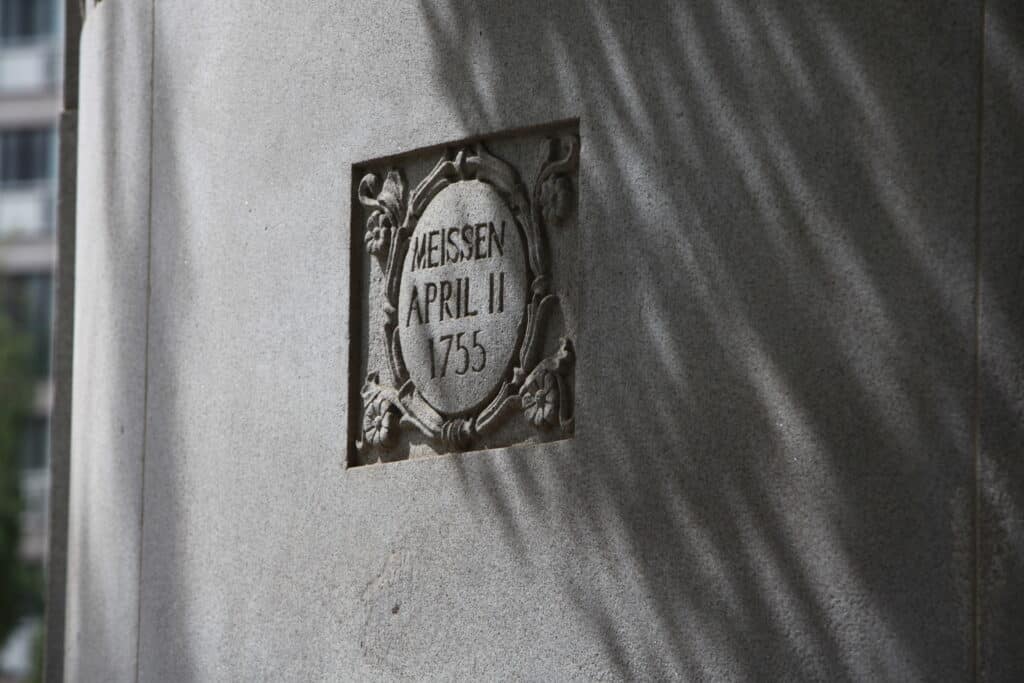
The inscription of Hahnemann’s death date and place appears on the rear of the left wall, encircled with laurel leaves.
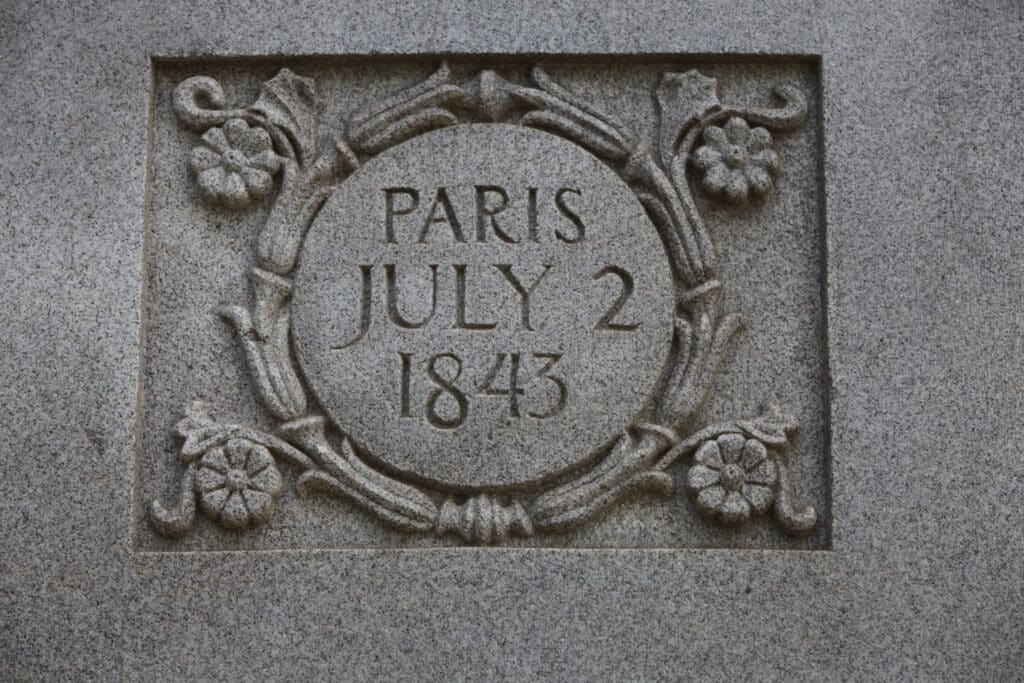
The forward-facing left wall terminus displays the names of significant places in Hahnemann’s life: at Erlangen he obtained his medical degree and at Dessau he began his chemistry studies. The lion heads depicted are a symbol of strength.
The forward-facing right wall terminus displays such names, also. Leipsic is the city in which he used his method successfully to treat typhus patients. Coethen was his home for fourteen years, during which time he wrote Chronic Disease. (*The house was restored by German Homeopathic MDs with worldwide fundraising.)
Latin phrases associated with Hahnemann appear on the monument, most characteristically, SIMILIA SIMILIBUS CURENTUR (Let likes cure likes) on the pedestal under his statue, but also, AUDE SAPERE (Dare to discern) and IN OMNIBUS CARITAS (In all things charity). DIE MILDE MACHT IST GROSS (The gentle action is the powerful) according to historian, Julian Winston, is attributed to Hering, circa 1845.
Again, one notes the presence of the Lion head in three places, including above the head of Hahnemann. (*The head was modeled from a bust in life given by widow Melanie to one of the American homeopathic colleges)
At the upper right portion of the niche depicts a lamp and a book, typifying knowledge and instruction (with laurel).
The upper left portion of the niche depicts a bowl and a serpent, symbolizing wisdom (with palm branch).
The beautiful mosaic in the arch depicts stylistically in gold leaf-backed Italian colored glass a stylistic rendition of the foliage and flower of Cinchona. (*When viewed with the sunlight falling on this arch it appears as if it were a stained-glass window.)
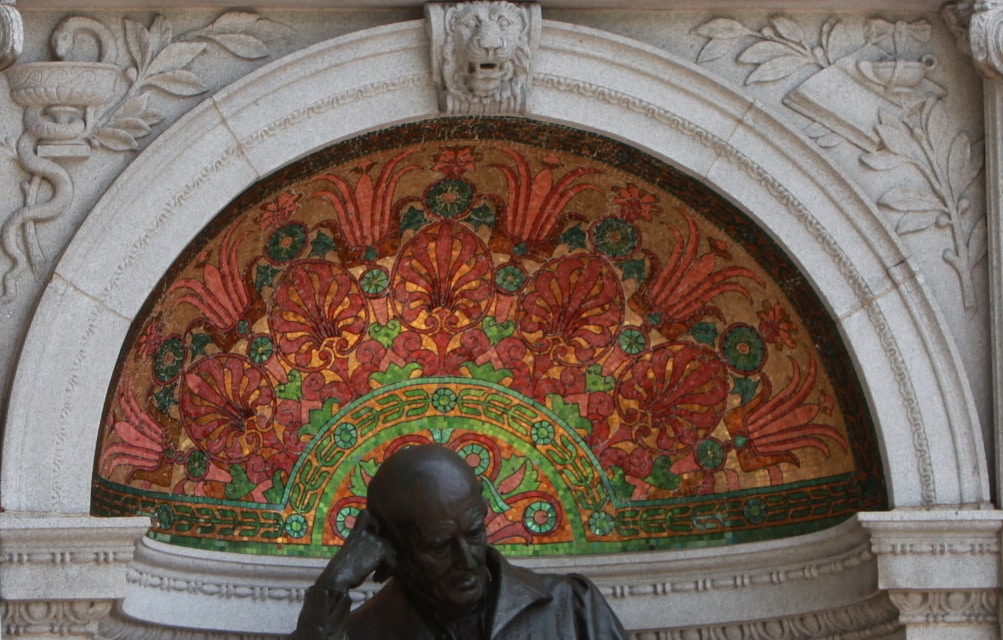
The bronze entablature to Hahnemann’s right depicts the nightly vigils of the student (1775-1777) and the investigations of the chemist (1779-1789).
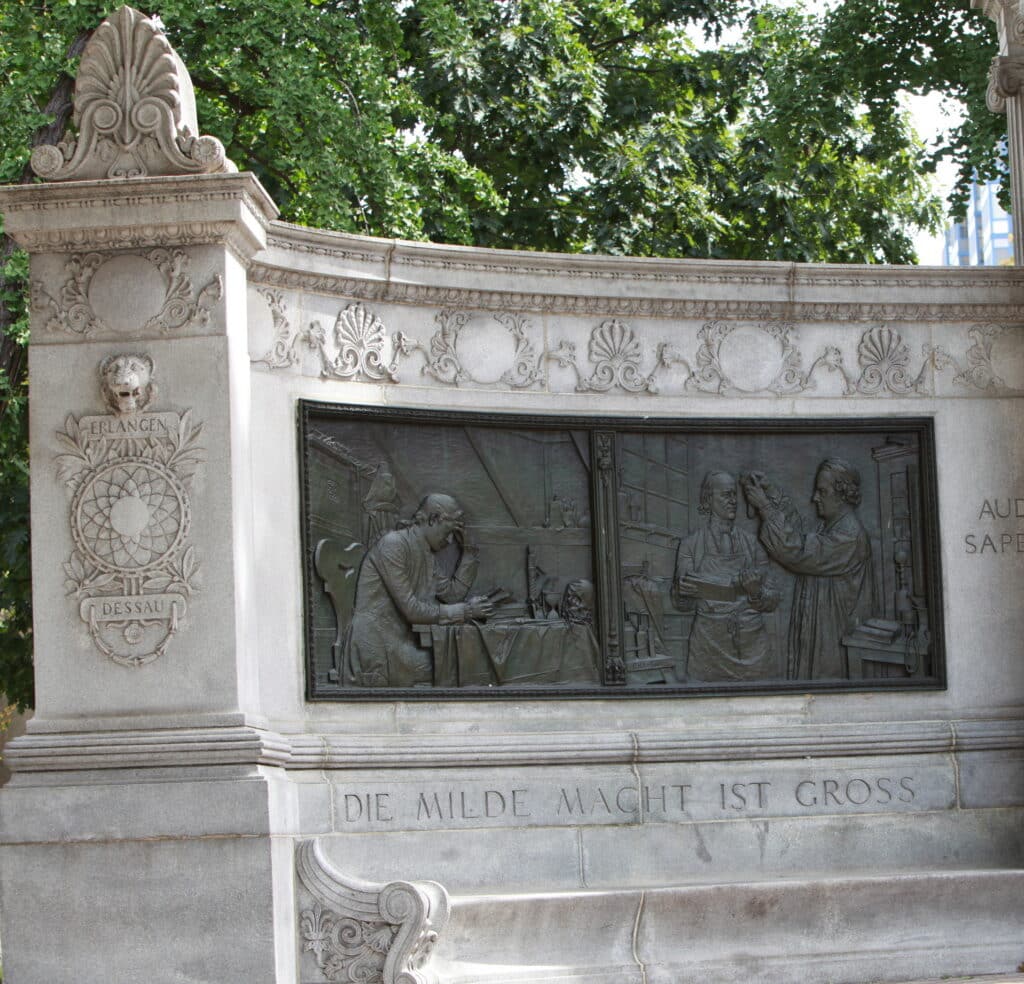
The bronze entablature to Hahnemann’s left depicts the self-experimentation and teaching (1790:Cinchona) and the successful treatment of the typhus patients at Leipsic (1813).
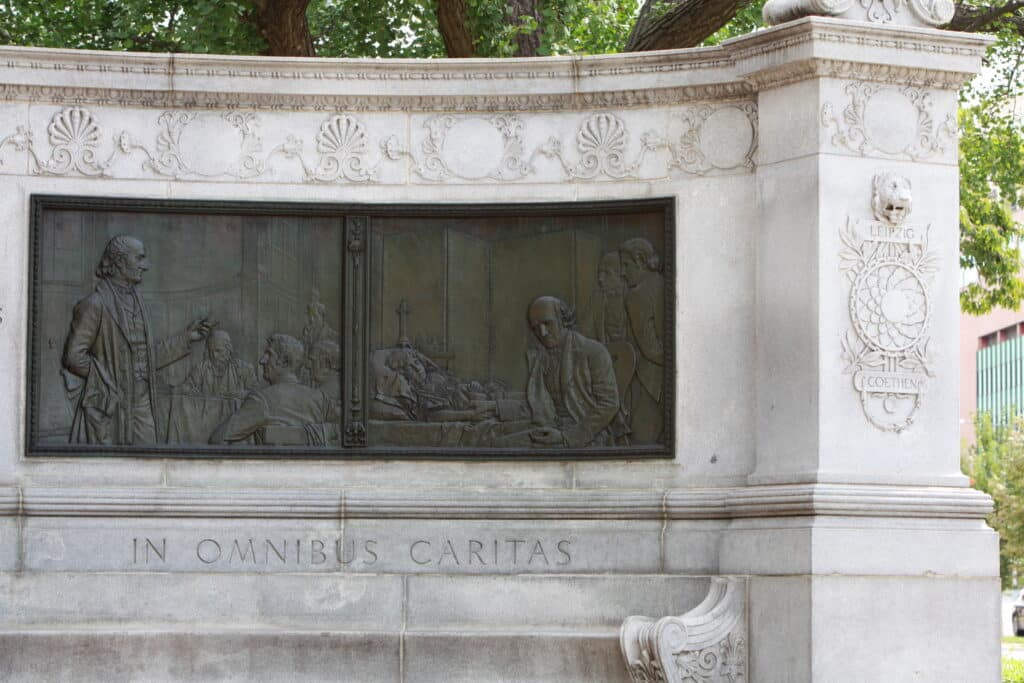
(*The figures in entablatures depict disciples of Hahnemann: Dunham, Gross, Hartman, Hering, Staph)
It is of note that Hahnemann is dressed in the robe of the scholar, a brilliant device on the part of the sculptor, Niehaus, as it makes his statue timeless.
The model of this monument won the Gold Medal at the Pan-American Exposition and was shown at the Louisiana Purchase Exposition (1903).
In 1913 the art critic, Charles Coffin, commented: “…finest work…equaled by few others in the country.”
The National Cyclopedia of American Biography also commented:
“A similar strength and adequacy of conception characterizes the statue of Hahnemann, discoverer of homeopathy, for the memorial in Washington, considered the most effective seated statue ever produced.”
